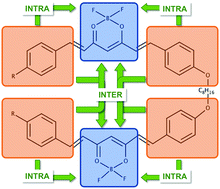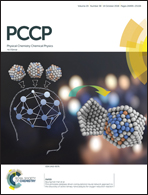Optical properties of quadrupolar and bi-quadrupolar dyes: intra and inter chromophoric interactions†
Abstract
In this work we present the synthesis, characterization and theoretical investigation of three boron-difluoride-curcuminoid derivatives and their covalent homodimers chemically linked through a polymethylenic chain. Low-lying electronic excited states and photophysical properties of the monomeric species have been described as the convolution of different donor–acceptor intramolecular excitations. Covalent dimers in solution can present open or folded structural conformations. Analysis of absorption profiles and computational results allow to identify the factors that control the relative stability of the two forms and rationalize its dependence with the solvent polarity. Interestingly, the strong electronic coupling in the folded forms results in low-lying excitations with sizable mixings of intra- and inter-chromophoric contributions, which cannot be described by means of the Kasha model of interacting chromophores. Our study demonstrates how decomposition of the computed excitations in terms of diabatic states can be extremely valuable in order to identify and quantify the nature of electronic transitions in the presence of several electron donor and acceptor fragments.

- This article is part of the themed collection: 2018 PCCP HOT Articles


 Please wait while we load your content...
Please wait while we load your content...